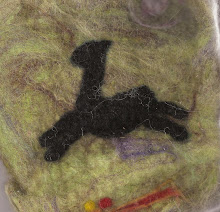I
have been listening to the book
"To Kill a Mockingbird". This afternoon I heard the part about the "mad" dog that they had to kill. The description of the dog and his behavior reminded me of Rocky, one of our young
suri males. It was January of 2008. Rocky had had a case of choke, and we were keeping a close eye on him. Choke can lead to
pneumonia and death, and Rocky came from a line that carried mega esophagus. That's another long story I won't cover here.
Anyhow, Rocky started acting strangely and appeared to be shivering. I put him in our sick bay, took his temperature and put a coat on him. He did not have a fever, but continued to shiver. I gave him some
penicillin as a precautionary measure and continued to watch him.
We had made the hard decision at one point, that if Rocky ever got really sick, we would not go to great lengths to save him. He was not a breeder, and we knew he carried this gene, which we would not want to pass on to any offspring.
I had been in the house for awhile, and when I came out, I found Rocky in the girl's pasture, walking in circles and humming. I went up to him, put my hand behind his ears, and led him into the barn again. It was then I discovered he had broken the lock on the stall he was in and had forced his way through the second gate. Darn, I'm crying as I'm remembering all this.
I got him secured in the stall, putting a heavy object in front of the gate so he was unable to get out again. It was at this point that I realized he was blind. He was also walking up to the wall and trying to walk through it. Meeting up with the wall did not deter him, he just kept trying to walk through it. (In the book, they said the dog would just walk
determinedly in a straight line, going through anything that got in it's way.)
I talked to my husband on the phone that night and said I thought I should have the vet out the next day to have Rocky put down. There was nothing we could do for him. But the more I watched him, the more disturbed I became.
The next day the vet got there. I told him he would think I was crazy, but that Rocky was exhibiting symptoms of rabies. So Gordon says, let's take a look. He agreed immediately that Rocky was blind. He examined him a bit more and then said "let's go outside". I got a chuckle out of that, as if he wanted to tell me something where Rocky couldn't hear us. But then he said he had to make a call. He got in his truck and closed the doors. He got out, starting to talk to me, and then went back to the truck and made another call. Finally he comes out and says:
"I don't mean to alarm you, but there is a chance that Rocky has rabies". He asked if I had had my hands in Rocky's mouth. I had, to see if there was something in his throat, and I had abrasions on my hands. Well, if he had rabies, I would have to be treated immediately, as well as vaccinating all of the herd. I was leaving for a Fiber to Fashion conference in
Las Vegas the next morning. This meant, if the tests proved
positive, I was to go to the emergency room in
Las Vegas to begin the series of shots. (while watching a nature show this year we learned that
Las Vegas does not have any rabies vaccine on hand). In order to test for rabies, they would have to send the head to Seattle for testing. It was rather
gruesome.
In Washington, the only animal that caries rabies is the bat. It was January, and as I recall, a very cold January. The bats were all hibernating, or whatever bats do in the winter. The only possibility we could come up with was a
raccoon having been bitten by a bat and becoming a carrier. We had several
raccoons in the barn that year.
Then there ensued a number of phone calls from the Department of Agriculture and the Department of Wildlife, asking me a million questions. I was starting to be a little nervous. I had been taking this all in stride, but when I saw how seriously the agencies were taking this, well, yikes, I might have been exposed!!
It takes 24 hours to get the results on the test of the brain, so I was in the airport in
Las Vegas, just meeting up with my
niece, when the call came in to tell me I did not have rabies. Phew. I could now concentrate on having a great time!!
What had happened with Rocky was that the choke had caused an infection in his brain. The alpaca has a tendency to aspirate when choking, which leads to
pneumonia in many cases. But for some reason, the choke took the route of the nasal passages and met up with the brain.
It seems the longer you have livestock, the more freaky things you see.
When we first bought alpacas, the salesman from the largest breeder in the area told us, "oh, raising alpacas is a no
brainer, they practically take care of themselves." Not so, my friends, not so.




























